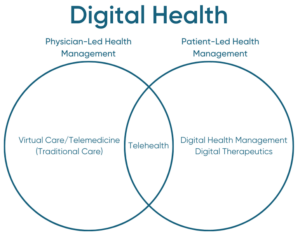Defining Digital Health
Digital. Virtual. Telehealth. Traditional. Let’s try to straighten out the latest healthcare terminology.
As digital health continues to evolve at a tremendous rate, we’ve noticed some confusion in the marketplace when it comes to labeling and defining different services.
At Dario, we like to keep things as simple as possible. Our credo for our end users—people with one or more common chronic conditions—is to make the right thing to do the easy things to do, and we strive to do the same for employers, health plans, and other business customers. When we consider the entire universe of health management activities, two primary categories start to become clear: physician-led and patient-led activities.
Physician-Led Health Management
Physician-led activities include direct interactions with providers, such as check-ups, prescriptions, procedures, hospital stays, urgent and emergency care, etc. These interactions are “traditional” when they involve doctors and patients in the same physical space. When a phone or computer is involved, the interactions fall under the virtual or telemedicine label.
We consider virtual care and telemedicine to be interchangeable. The key is that a digital connection is made between a patient and his or her doctor, eliminating the necessity for travel to—and waiting in—a doctor’s office. Virtual care is much more convenient than traditional care in cases where sharing the same physical space isn’t mandatory.
According to the National Center for Health Statistics, “the demonstrated benefits of telemedicine include improved access to care, convenience, and slowing spread of infection.” Based on data obtained in 2021, 37% of adults aged 18 and over took advantage of telemedicine services in the previous 12-month period.

Patient-Led Health Management
At the other end of the spectrum are patient-led activities that don’t involve direct interaction with a doctor. These include exercise, medication adherence, eating right, and monitoring vital statistics such as blood glucose, blood pressure, and weight.
Most Americans need help when it comes to patient-led health management activities. According to the Centers for Disease Control and Prevention (CDC):
- Obesity prevalence in the U.S. is up to 41.9%
- Nearly half (47%) of U.S. adults have hypertension
- One in five new prescriptions is never filled, and among those filled, about 50% are taken incorrectly
Fortunately, digital tools have been created to motivate and facilitate healthier behaviors. These tools give patients greater control over their own health in between doctor’s visits, so when physician interventions are needed, they’re less frequent and less severe.
The term digital health management includes all the digital tools that help patients make healthier choices and create healthier habits, from collecting blood glucose data on a smartphone and watching educational videos to automated medication reminders and contact with a dedicated coach.
A subset of these tools, known as digital therapeutics, are evidence-based therapeutic interventions designed to prevent or treat a specific condition. These include self-guided cognitive behavioral therapy (CBT) programs and posture training devices that alert users when they start to slouch.
The Expansion of “Telehealth”
As more solutions try to connect doctors and patients through new and emerging avenues, the lines between them continue to blur. The word “telehealth,” for example, originally described the act of accessing doctors virtually, but its definition has come to include activities associated with digital health, namely the monitoring of vital statistics such as blood glucose levels and blood pressure.
While we acknowledge some overlap among terms, especially “telehealth,” we will continue to separate “virtual care” and “telemedicine” from “digital health management” and “digital therapeutics.” For us, the most important distinction is whether a person is accessing a professional for medical care or using tools to empower themselves.
Despite some confusion, we believe that the benefits of digital tools for patient-led health management are worth promoting—no matter what people end up calling them.